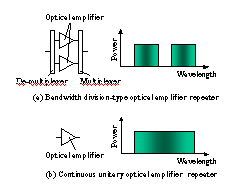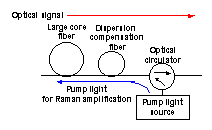 |
2001-0211E
Fujitsu Laboratories Ltd.
Fujitsu Successfully Demonstrates Technology Enabling
Optical Wavelength Division Multiplexed Communication
Over 7400 km at 2.4 Terabits/Second
|
Kawasaki, October 24, 2001 - Fujitsu Laboratories Ltd. today announced a pathbreaking research achievement in the multi-terabit wavelength division multiplexing (WDM) technology that will be applied for the high-capacity, high-speed broadband Internet of the future. Fujitsu has successfully demonstrated transmission of WDM signals at 2.4 terabits/sec over a distance of 7400 km using a single band between 1536 nm and 1610 nm. This new research accomplishment would make possible trans-Atlantic (about 6,500 km) data transmission at 2.4 terabits/sec over a single fiber by multiplexing a 10-gigabits/sec signal into 240 channels.
Moreover, because Fujitsu's newly developed Raman amplifier technology enables amplification of WDM signals with a continuously single bandwidth of 74 nm, significant advances are expected to be made in simplifying repeater configuration, reducing optical noise, increasing output power and reducing costs.
Fujitsu announced the development at the recent 27th European Conference on Optical Communication (ECOC'2001), which took place in Amsterdam.
Background
Data communications volume is set to increase explosively as broadband Internet becomes more widespread, driving demand for the development of dramatically higher-capacity, long-distance data transmission systems. WDM technology, which enables the transmission of multiple optical wavelengths over a single fiber, can achieve high-capacity data transmission in parallel with increases in the number of wavelengths.
There are two key methods of increasing transmission capacity: increasing the number of optical signal wavelengths transmitted within a fixed bandwidth (the high density approach), and broadening the bandwidth to accommodate an increased number of wavelengths. However, at high densities, neighboring signals cause a strong nonlinear effect (*1) along the fiber over which they are transmitted, and the resulting waveform distortion makes long-distance transmission difficult. And with conventional transmission methods using erbium-doped fiber amplifiers (*2), there are limits to expanding bandwidth, since it is constrained by the gain wavelength characteristics.
Up to now, these problems have been addressed by employing a method of dividing the bandwidth among multiple amplifiers and then combining the optical amplifiers handling the various divided bandwidths for transmission (Fig. 1 (a)). However, this has the disadvantage of requiring optical amplifiers for each of the signal band as well as multiplexers and de-multiplexers, which increases the size of the equipment as well as costs.
Accordingly, there has arisen a need for development of a technology whereby equipment could be simplified and long-distance transmission facilitated by amplification in single WDM band (Fig. 1 (b)).
Fujitsu's New Technology
Fujitsu has developed a Raman amplifier (*3) for amplifying WDM signals that have been attenuated as they transmitted over a optical fiber as well as a hybrid transmission line employing two types of optical fibers suitable for Raman amplifier. Using only the new Raman amplifier as an optical repeater and combining it with the hybrid transmission line, Fujitsu achieved continuous expansion of the wavelength bandwidth up to 74 nm and improvement of the signal-to-noise ratio (optical S/N ratio).
Two important features of the technology are detailed below:
(1) Broadband optical amplifier (Fig. 2)
Optimizing the pump wavelength and optical power for the Raman amplifier produces consistent gain wavelength characteristics. At wavelength bandwidth between 1536 nm to 1610 nm (74 nm) with a wavelength spacing of about 0.3 nm, Fujitsu was able to simultaneously amplify an 240-channel WDM signals using only the Raman amplifier.
(2) Broadband transmission fiber suitable for Raman amplifier
Fujitsu used optical fibers with two different characteristics to have a broadband transmission performance. That is, a hybrid transmission line consisted of a large core diameter, low-loss optical fiber at the front end of the repeater span and, at the opposite end, an optical fiber that can compensate for a chromatic dispersion causing a waveform distortion in the first optical fiber. This has produced broad bandwidth and low optical noise while decreasing waveform distortion.

|

|
| Fig.1: Repeaters and optical spectra |
Fig.2: Broadband optical amplifier |
Fujitsu Limited already has a commercially available terabit-class optical undersea cable system with 105-channel 10-gigabits/sec WDM signals. Fujitsu Laboratories' newly developed technology offers the prospect of further increasing system capacity, reducing the complexity of the optical amplifier repeaters, reducing optical noise, increasing output power and reducing costs. Fujitsu will now engage in detailed research into the practical application of the new technology, which it expects to incorporate into products around 2005.
Terms and explanations
- Nonlinear effects:
When an optical signal enters an optical fiber, the amplitude of the incident optical signal power varies the refractive index, which means the light speeds of it and other wavelengths are modulated. Especially in the case of long-distance transmission of up to 10,000 kilometers or 100 or more multiplexed wavelength signals, the accumulation of this effect becomes serious. Accordingly, cross talks occur among the WDM signals during the transmission and the waveforms are gradually distorted. The degree of distortion caused by the occurrence of nonlinear effects is closely related to the chromatic dispersion in the fiber, so the highly accurate dispersion management in the transmission line is required. With the pump light, the signal light is amplified by scattering due to the molecule vibration in the substance of which the fiber is composed. This is a nonlinear effect called the stimulated Raman scattering.
- Erbium-doped Fiber Amplifier
An amplifier that amplifies an optical signal in the 1.5-mm band, employing pump light at 0.98 mm or 1.48 mm in an optical fiber doped with the element erbium. It has found wide practical application in WDM transmission systems.
- Raman Amplifier
An amplifier that employs pump light in the 1.4-mm band and amplifies an optical signal in the 1.5-mm band, applying the stimulated Raman scattering effect. It has already been applied for repeater-less transmission systems. Adjusting the pump wavelengths and optical power allows engineers to freely design advantageous gain wavelength characteristics.
* All company/product names mentioned may be trademarks or registered trademarks of their respective holders and are used for identification purpose only.
About Fujitsu Laboratories Ltd.
Founded in 1968 as a wholly owned subsidiary of Fujitsu Limited, Fujitsu Laboratories Limited is one of the premier research centers in the world. With a global network of laboratories in Japan, China, the United States and Europe, the organization conducts a wide range of basic and applied research in the areas of Multimedia, Personal Systems, Networks, Peripherals, Advanced Materials and Electronic Devices.
About Fujitsu Limited
Fujitsu is a leading provider of Internet-focused information technology solutions for the global marketplace. Its pace-setting technologies, best-in-class computing and telecommunications platforms, and worldwide corps of systems and services experts make it uniquely positioned to unleash the infinite possibilities of the Internet to help its customers succeed. Headquartered in Tokyo, Fujitsu Limited (TSE:6702) reported consolidated revenues of 5.48 trillion yen for the fiscal year ended March 31, 2001. For more information, see: http://www.fujitsu.com/

|
Please understand that product prices, specifications and other details are current on the day of issue of the press release, however, may change thereafter without notice.

|